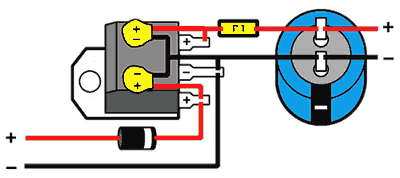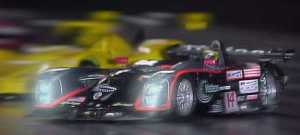|
The basic set-up
is a quite simple 6 volt circuit. It might look complicated if you
see all those bits and wires cramped together in the car, but we'll
lead you through the installation step by step.
In the left colomn you will find a list with parts commonly used in
a basic set-up.
The drawing shows where and how they should
be connected.
You 'll see that they are nicely grouped together, the red wire is
always the + (positive, the black wires are - (negative or ground).
If you follow the sequence indicated in the drawing, it will make
no difference you where place the separate parts, on the chassis or
in the body.
Step 1
We'll start on the left off the drawing, both wires come from the
Motor.
The first step is a 1 amp 16v Diode in the + (Plus in)
wire feeding the circuit.
This to prevent any current flowing back to the motor (and to prevent
cheating).
In a diode the current can flow in just one way, this is indicated
by a silver ring on the diode.
The wire from the motor must be connected to the other side.
Step 2
During the races the track voltage is ±20 volt. This is of
course far to high for the l.e.d's used as lights.So we use a voltage
regulator to bring down the voltage to 6 volts.
The regulator has 3 pins: The bottom pin is the positive
in, connect the wire coming from the diode to this pin. The
centre pin is the common negative, connected tis pin to the
to negative wire (-) leading to the motor. The
top pin is the positive out.
Step 3
To prevent any voltage oscillations 2 small capacitators
are connected to the + in and +out pin
of the regulator. The negative of both capacitators is connected to
the center pin of the regulator.
At the top pin (+ out) you now have a stable 6 volts.
Step 4
To keep the lights burning under braking, a small rechargeble battery
is included in the circuit.
It is best to use a small 47 Ohm restistor in
the +out wire off the regulator (R1 in the drawing)
This will prevent the battery from draining power from the motor while
charging.
After the resistor you should have 5,5 volts.
Step 5
Last step in the circuit is the rechargeble battery it self; the Goldcap.
You should use one of 5,5 volt, 0,2 or 1,0 fahrad
(smaller value=smaller and lighter battery). The negative pin of the
Goldcap is indicated by a black stripe on the cilinder. Connect this
pin to the center pin(negative) of the regulator. Connect the positive
pin to the resistor R1
Step 6
The wires on the right will lead to the lights, connecting them should
be no problem but remember that you now have a 5,5 volts. You should
calculate you resistor values accordingly.
|

 Night
racing is one of the most spectacular features of the LMS.
Night
racing is one of the most spectacular features of the LMS. 